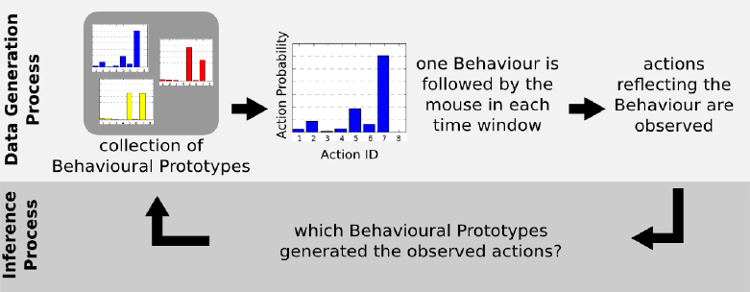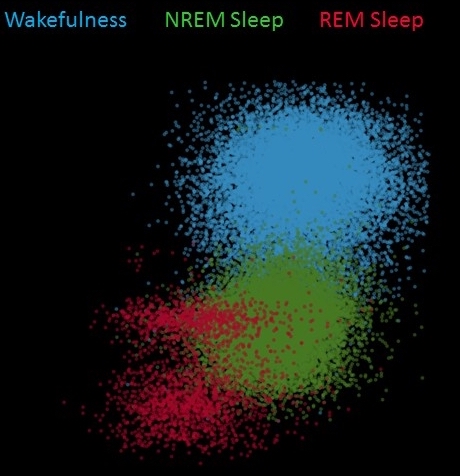Mouse behavior analysis plays a key role in pre-clinical research for the investigation of diseases characterized by behavioral dysfunctions, like sleep disorders, autism spectrum disorder, social anxiety, schizophrenia and other social and non-social disorders. Mouse models are increasingly used to understand the biological basis of many pathologies. Indeed, behavior analysis of genetically modified mice allows to get insights about particular genes, phenotypes or drug effects on specific disorders.

Mouse behavior analysis is usually performed by manually scoring actions or events of interest in recorded experiments. While large datasets are required to evaluate behaviors with a significant statistical relevance, extensive recordings pose serious issues to be solved, as the manual annotation can be extremely time-consuming and prone to errors. Hence, the throughput of behavior analysis techniques can be considerably increased by automatic or semi-automatic tools leading to advantages in time, repeatability and precision.
To this aim we exploit our expertise in Machine Learning, Pattern Recognition, Signal Processing and Image Analysis to harness multiple recording modalities and develop algorithms that push forward the limitations of current mice behavior analysis tools. A technological evolution much needed for all behavioral studies. Indeed, our group does research and develops methods for the analysis of mice behavior ranging from basic statistics on tracking of single mouse to the analysis of concurrent multiple-mice interactions.
Mice Tracking>
A robust animal tracking system is an important first stage in the development of tools for behavior analysis studies, and like in any other multiple target tracking system, identity preservation and minimization of identity swaps in case of occlusions is the main goal. We approached this problem with a variety of methods implementing a range of different trackers, both in 2D top-view and in 3D. A software suit has been also developed allowing the neuroscientists to use the different trackers and correct possible mice identity swaps with an interactive user-friendly interface. In all our experiments we analyze the social behavior of mice in night-light, the time in which mice present highest activity, hence, our tools are all based on videos recorded with thermal cameras. References:
|
Analysis of Social InteractionsSocial interactions are made of complex behavioral actions that might be found in all mammalians, including rodents. Reliable and flexible automatic systems able to precisely quantify social interactions of multiple mice are still missing. Hence, our aim is to develop behavior analysis methods ranging from supervised behavior classification to unsupervised discovery of social and non-social atomic actions, and abstraction of prototypical high-level behavioral patterns.
Supervised Classification of Behavioral ActivityManual scoring of social interactions is still the principal experimental bottleneck in behavioral studies as it is affected by a number of limitations such as scarce replicability and lack of standardization. It is extremely time consuming and challenging to visually follow subtle and composite social behaviors, especially when multiple animals are involved. As a consequence, more explanatory long-lasting and/or large-scale studies are still unaffordable. To this aim we are working on systems allowing to automatically classify mouse behaviors using a learning-by-examples approach. Indeed, an expert manually scores a piece of video and then the system learns from the video how to label the animal behavior in other videos. Systems are being developed to deal with both single mouse behavior, and multiple interacting mice, managing the multiplicity and complexity of various interaction models. This is made possible by a proper representation of possible pairwise interactions through spatio-temporal features, followed by the analysis performed with a classification approach exploiting temporal information. All pairwise interactions are then properly managed in order to have a single behavior for each mouse at any given time-point. References:
Unsupervised Discovery of Social Interactions
Systems based on supervised learning methods are capable of recognizing the set of animal activities as defined by the expert. However, the prior assumption on the set of actions that need to be monitored might be inaccurate as this set might result to be insufficient or limited in order to characterize specific behavioral pathologies. Our goal is to uncover the underlying data structure and present a way for exploiting unlabeled data by automatically detecting meaningful social and non-social activities that a human expert might not be aware of. To this aim, we introduce a completely unsupervised approach for the analysis of tracking data, aiming at automatically identifying recurring social and non-social activities that extend over long periods of time. The proposed methodology aims at capturing richer information in the observed data, avoiding the use of behavioral categories as defined a priori by experts, in order to support behavioral scientists in data-mining and exploratory data analysis. This is obtained employing latent variable models capable of spotting regularities in the data. In particular, various Restricted Boltzmann Machines (RBMs) models stacked in a multilayer framework are used to abstract higher-level behavioral configurations of mice interacting in an arena. These allow to model the interaction between mice and to uncover repetitive behavioral configurations without the need for any prior knowledge about the input data. References:
Automatic Identification of Behavioral Prototypes The working hypothesis of this research activity is grounded on the assumption that the behavior of an animal is characterized by recurring sequences of actions. The task, therefore, is to identify prototypical high-level behavioral patterns, going beyond simple atomic actions. This is especially useful both when interesting behavioral patterns can only be appreciated over long time intervals, and when such behaviors are not known a priori. In this framework, behaviors are considered to be high-level entities obtained by aggregating lower-level atomic actions. Addressing this task we designed a method, based on a Bayesian Nonparametric model (a Dirichlet Process Mixture of Multinomials), which is able to find an appropriate collection of behavioral prototypes in a completely unsupervised way. These prototypes are then used to characterize mice behavior and present the user with a high level aggregation of the data capturing salient behavioral features, supporting behavioral scientists in exploratory data analysis and hypothesis formulation. References:
|
Mouse Sleep Analysis

Sleep disorders are important clinical problems encountered in medicine and psychiatry, and mouse models play an important role in preclinical studies of such pathologies, due to the fact that mice share most genes and gene functions with humans and other mammals. They also display brain electrical activity during sleep which has underlying similarities to that of humans' sleep. The main tools for studying the sleep in mice are Electroencephalogram (EEG) and Electromyography (EMG) recordings, measuring respectively the brain activity and the activity of skeletal muscles. To score different sleep stages, a manual analysis of recordings is usually performed. The goal of our research is, therefore, to provide tools that facilitate dealing with large experiments.
Machine learning methods have been extensively used for developing sleep scoring systems. However, direct comparison among these system was never carried out, because of the absence of shared standards and datasets. In our tests, we observed that the selection of an appropriate pre-processing pipeline is far more important than the choice of the classifier itself. Hence, beyond the creation of a sleep scoring system we are also interested in the definition of a good encoding of data
Automatic scoring of sleep stages is not, however, our primary focus. As for social behavior, our aim is to uncover the hidden structure in the data, discovering new useful feature configurations without being bounded by human perception and intuition that might limit the discovery of novel insights. The goal is, therefore, a different way of studying the sleep in mice based on unsupervised learning, supporting the analysis of large amounts of electrophysiological data.
To this end, in a way similar to the social behavior analysis, we employed latent variable models capable of spotting regularities in the data. Our experiments show that this approach allows for effectively discovering meaningful feature representations which characterize sleep stages at a finer granularity than the one commonly used by the experts. This allows to explore open questions, like the homogeneity of sleep stages, and present a methodology capable of performing multi-subject analysis uncovering behavioral differences between different groups of mice.
References:
- V. M. Katsageorgiou, G. Lassi, V. Tucci, V. Murino and D. Sona
"Sleep-stage scoring in mice: The influence of data pre-processing on a system's performance"
37th Annual International Conference of the IEEE Engineering in Medicine and Biology Society (EMBC), 2015, Milan, Italy
